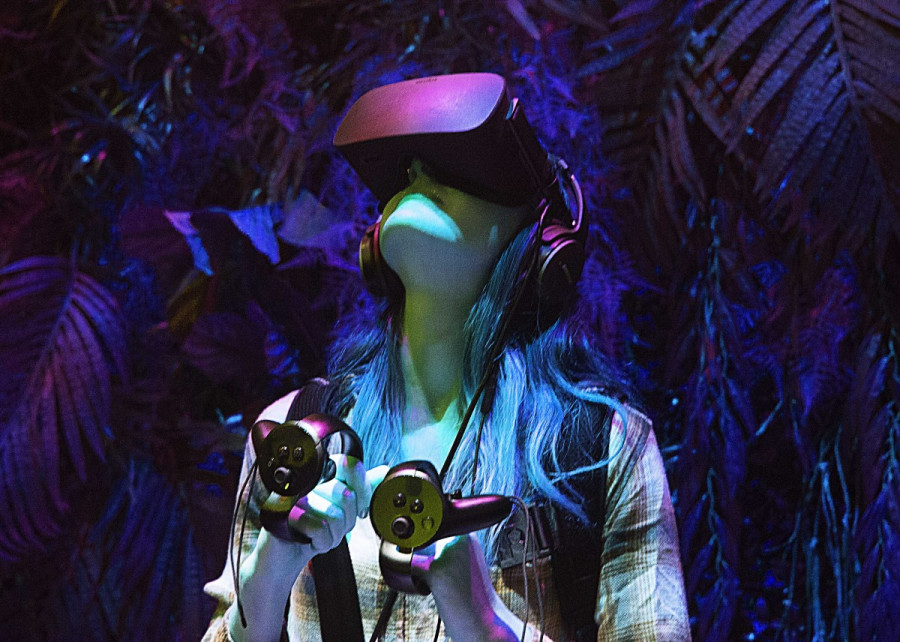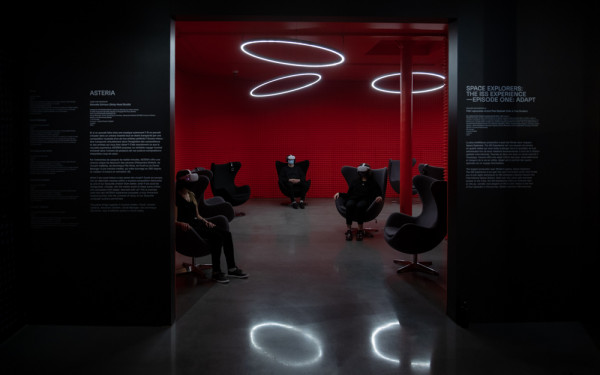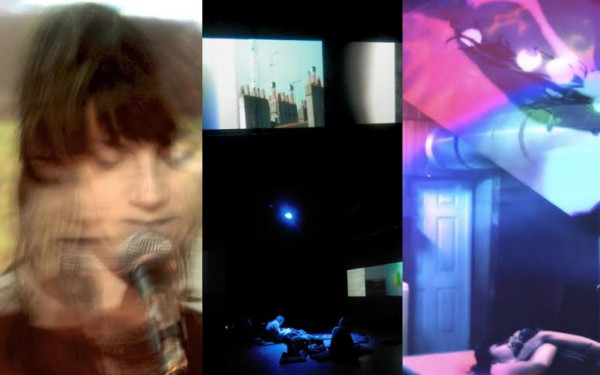Development of Immersive Environments and Virtual Reality in Montreal
Research, Projects, and Play-Ins at Concordia and the Phi Centre
In a memorable Black Mirror episode, a man tests an immersive virtual reality horror video game that is so believable he dies of fright.
In another, soldiers have virtual reality chips implanted in their brains that makes them see others as monsters, allowing them to kill without remorse.
There is a lot of paranoia when it comes to the future of virtual reality, but luckily for us, the technology hasn’t advanced to that level yet.
In Montreal, there’s a lot of work being done in the technology’s development. Virtual reality, or immersive environments, is a technology that lets a person dive into a new world through a set of glasses coupled with audio and hand tracking that monitors your position in a virtual environment.
Some haptic controllers extend the experience by getting the physical feedback into the body. It tricks the brain into thinking you’re somewhere else and in another world.
There are two kinds of immersion. First, there’s immersive cinema which comes from cinematographers using existing technology. They use a 360-degree camera and film all directions at once, so when you play back the tape the user can look all around and isn’t confined to the frame. The viewer isn’t on the outside looking through a frame into the world, the viewer is the centre of the world.
This approach can be seen as solipsistic in the sense that the self is perceived to be all that there is.
The other approach is a synthetic environment. These environments are created from scratch in computers with gaming software and programming.
According to Jason Lewis, a professor of design and computation arts at Concordia, the metric that’s used to measure if a reality is truly immersive is, “How close was it to [being] real?”
“Starting in the early 90’s when artists got a hold of the technology to create these immersive environments, people started asking if the goal shouldn’t actually be recreating reality. Maybe the goal should be creating new realities, things that we can’t actually experience in the real world,” he said.
Momentum in the game industry built for years as developers tried to increase graphics power to get closer to reality. The same mentality was applied to immersive environments, as the people who were working on the technology were mostly coming from game design backgrounds. This lead to immersive reality being created mostly for games.
Virtual Reality in Montreal
At the Phi Centre, in a vertigo-inducing immersive virtual reality experience, you can live the life of a tree at the Lucid Realities exhibit. In Tree, you get to watch yourself grow, smell the forest, and feel the wind as you sway from side to side in a jungle. Then you can watch yourself die in a forest fire.
That, or you can experience all of evolution, and go from being a cell to a cyberman until the world dies. The Life of Us is played with two people, and can be interpreted as a criticism of humanity’s capitalist obsession with progress despite the fact that we’re killing the planet. In one part of the game you’re a monkey wearing a suit rushing through the streets of a big city.
You can also choose to wander in space in search of objects in the virtual reality video game Fragments. This game is over an hour long but the Phi Centre lets you play a seven-minute demo. It’s more about testing the technology than the game itself, they say, and the goal of the exhibit is to expose people to situations that tend to be inaccessible to us and “elicit more visceral and emotional reactions,” explains the Phi Centre’s website.
“Not everyone has virtual reality gear at home, so we want to be able to democratize the access to new technology,” said Myriam Achard, the Phi Centre’s director of public relations and communication.
Casa Rara and Technoculture, Arts and Games
Casa Rara is a Concordia-based virtual reality studio as part of a milieux that does research and creation with design, art, culture, and technology. It was founded by Ruben Farrus and Tali Goldstein.
Casa Rara aims to allow artists to be able to learn about, explore, and create virtual realities on a budget. Artists, programmers, and designers use game production engines like Unity 3D and Unreal4 to create fictional and fantastical worlds.
Casa Rara are currently working on two projects with the National Film Board of Canada. The first will be the Museum of Symmetry. The project is in collaboration with Paloma Dawkins, an illustrator from Montreal who creates colourful and trippy graphic novels and illustrations.
“It’s like Alice in Wonderland in VR,” said Farrus. “It’s a really cool visual style.”
The other project is called Westwind, and is set in a post-apocalyptic world. The project was created by Jeff Barnaby, who is making his first virtual reality film with the NFB and is producing it through Casa Rara.
Concordia also has the Technoculture, Arts and Games Research Centre, otherwise known as TAG. As well as studying and researching games and gaming culture, and hosting workshops and labs, TAG works with students and faculty to bring digital art projects to life.
Last year Daniel Cross, Benjamin Gattet, and Marco Luna created a virtual reality game, I AM THE BLUES, through TAG. The game was based on the film of the same name directed by Cross. According to the project description, users can visit the Blues Front Café, “home [of] the legendary Jimmy ‘Duck’ Holmes and ground zero for the blues in Mississippi” in the 3D exploration game. It also says users can gain information on the characters through text, images, audio and video clips that are discovered by interacting with the environment.
We want to be able to democratize the access to new technology. – Myriam Achard
VR’s Roots in Military Development
The first immersive environments to convince the eyes and body that something is happening were created in a military environment, namely flight simulations.
According to Lewis, militaries are investing in creating simulators that allow a pilot to practice flying in VR, as opposed to training in an aircraft, which is time-consuming and expensive. Much of the earliest work came out of projects that were funded by the Defense Advanced Research Projects Agency in the United States.
Virtual reality’s roots in the military received a lot of criticism as it was commercialized. One point that Lewis makes is that VR is argued to be the product of a “particular military industrial complex that is dominated by masculine ways of interacting with the world, in that it’s designed to dominate virtual realities,” rather than being used to create and find new and better virtual worlds that would benefit humans.
90s to Present
According to Lewis, we are currently in the third wave of commercialized consumer-grade virtual reality.
The first wave was in the early 1990s, after the Virtual Reality Modelling Language was introduced in 1994. VRML is a text file format for 3D interactive vector graphics, specifically with the web in mind behind the design. It was eventually replaced by X3D in 2001.
In 1996, California’s Silicon Graphics manufactured InfiniteReality, a 3D graphics architecture and graphic system. It was marketed to companies for computer simulations and digital content creation. This marked the beginning of non-industrial virtual environments.
In a second wave at the end of the 1990s, companies were selling consumer-grade tools for virtual environments. However, it quickly flamed out.
Lewis considers us to be in the third wave of consumer-grade virtual realities and believes that this one will stick, as the hardware is robust enough, and people have an interest in it. But Farrus says the sale numbers are not yet massive, and so VR still hasn’t reached a significant mass of people.
“It’s still a very new technology and lots of companies are using it such as Google, Samsung, and the Oculus Rift, but we’re not sure if it will really take off,” he said. “It’s very expensive and the content available is still limited.”
According to Farrus, there have been concerns that the headsets can be harmful to the eyes, with the screens being so close to them, but there aren’t any conclusive studies on the subject.
“It’s also an expression of a sort of misanthropic tendency to denigrate the body—the physical form—and privilege the cerebral,” Lewis noted. “By going into these worlds you’re leaving the real world behind, so what does that mean? It’s escapism at its heart, and is that okay?”


_600_832_s.png)



